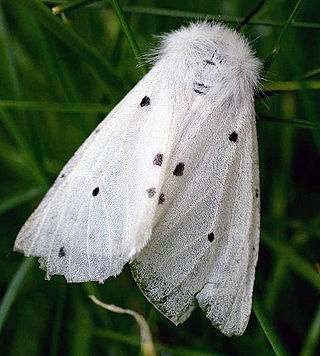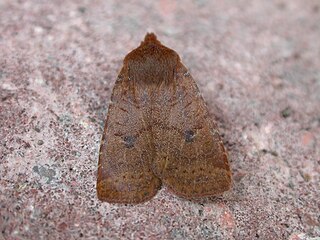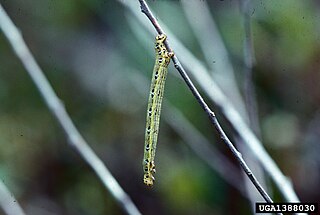
The common wave is a moth of the family Geometridae. The species was first described by Giovanni Antonio Scopoli in his 1763 Entomologia Carniolica. It is found throughout the Palearctic region and the Near East.

Hyles euphorbiae, the spurge hawk-moth, is a European moth of the family Sphingidae. It has been found in Pontresina, Switzerland. This hawk moth is used as an agent of biological pest control against the noxious weed leafy spurge, but usually only in conjunction with other agents. The larvae consume the leaves and bracts of the plant. The species was first described by Carl Linnaeus in his 1758 10th edition of Systema Naturae.

Idaea dimidiata, the single-dotted wave, is a moth of the family Geometridae. It is a Holarctic species.

Heliothis peltigera, also known as the bordered straw, is a species of moth of the family Noctuidae.

Diaphora mendica, the muslin moth, is a moth of the family Erebidae. It is found in the Palearctic realm east to Lake Baikal.

Spilosoma lubricipeda, the white ermine, is a moth of the family Erebidae. It is found throughout the temperate belt of Eurasia from Europe through Kazakhstan and southern Siberia to Amur Region, China, Korea and Japan. In China several sibling species occur.

Setina irrorella, the dew moth, is a moth of the family Erebidae. The species was first described by Carl Linnaeus in his 1758 10th edition of Systema Naturae. It is found in the Palearctic from Ireland, then through Europe and east to northern and central Asia to the Pacific Ocean. It is missing in the high north and parts of the Mediterranean region. It is found also in the limestone Alps up to 2,000 meters above sea level.

Phragmatobia fuliginosa, the ruby tiger, is a moth of the family Erebidae.

Conistra vaccinii, the chestnut, is a moth of the family Noctuidae. The species was first described by Carl Linnaeus in 1761. It is distributed throughout Europe, North Africa and east through the Palearctic to Siberia.

Xestia baja, the dotted clay, is a species of moth of the family Noctuidae. It is found in Europe, Turkey, northern Iran, Transcaucasia, the Caucasus, central Asia, Siberia, Mongolia, Tibet, China, Korea and Japan.

Athrips mouffetella is a moth of the family Gelechiidae. It is found from central and northern Europe to the Ural Mountains, Siberia and the Russian Far East. It has also been recorded from North America.

Cingilia is a monotypic moth genus in the family Geometridae erected by Francis Walker in 1862. Its only species, Cingilia catenaria, the chain-dotted geometer, chain dot geometer, chainspotted geometer or chain-spotted geometer, was first described by Dru Drury in 1773. It is found in North America from Nova Scotia south to Maryland and west to Kansas and Alberta.

Leucania loreyi, the cosmopolitan, false army worm or nightfeeding rice armyworm, is a moth of the family Noctuidae. It is found in most of African countries, the Indo-Australian subtropics and tropics of India, Sri Lanka, Myanmar, the eastern Palearctic realm, and the Near East and Middle East. The species was first described by Philogène Auguste Joseph Duponchel in 1827.
Cissusa indiscreta, the indiscreet cissusa moth, is a species of moth in the family Erebidae. The species is found from British Columbia, south to California and in the south-west from Arizona to central Colorado. The habitat consists of oak woodlands and mixed hardwood forests.

Chilo plejadellus, the rice stalk borer moth, is a moth in the family Crambidae described by Johann Leopold Theodor Friedrich Zincken in 1821. It is found in North America, including Illinois, Ontario, Quebec, Pennsylvania, Georgia, Louisiana, Wisconsin, Texas and Arkansas.

Pseudotelphusa paripunctella is a moth of the family Gelechiidae. It is found from most of Europe to Siberia and the Caucasus.
Pareupithecia is a genus of moths in the family Geometridae. It contains only one species, Pareupithecia spadix, which is found in the Russian Far East, Korea, Japan (Honshu) and Shanxi, China.

Hydriomena divisaria, the black-dashed hydriomena moth, is a moth in the family Geometridae. It is found in North America, where it has been recorded from southern Canada and the northern United States, south to Georgia in the east.
Cissusa mucronata is a moth of the family Erebidae. It is found in North America, where it has been recorded from Arizona and Texas.
Cissusa valens, the vigorous cissusa moth, is a species of moth in the family Erebidae. It is found in North America, where it has been recorded from Utah east to Colorado, south to western Texas and west to Arizona.















